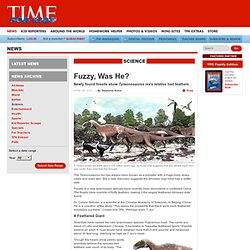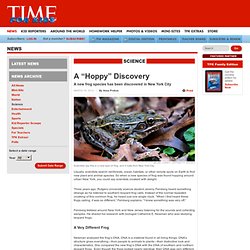

Fuzzy, Was He? The Tyrannosaurus rex has always been known as a predator with a huge body, sharp claws and scaly skin.

But a new discovery suggests the dinosaur may have had a softer side. Fossils of a new tyrannosaur species have recently been discovered in northeast China. The fossils have imprints of fluffy feathers, making it the largest feathered dinosaur ever found. Dr. Corwin Sullivan is a scientist at the Chinese Academy of Sciences, in Beijing, China. A Feathered Giant Scientists have named the new tyrannosaur species Yutyrannus huali. The newly discovered shaggy tyrannosaur species suggests T. rex may have also had a feathery coat. Though the fossils show patchy spots, scientists believe the species had feathers over much of its body. A team of Chinese and Canadian scientists studied three well-preserved fossils. Cretaceous Era The large size and soft feathers of Y. huali would have made flying impossible.
The Cretaceous Period is known to have been generally warm. A “Hoppy” Discovery. Usually, scientists search rainforests, ocean habitats, or other remote spots on Earth to find new plant and animal species.

So when a new species of frog was found hopping around urban New York, you could say scientists croaked with delight. Three years ago, Rutgers University science student Jeremy Feinberg heard something strange as he listened to southern leopard frog calls. Instead of the normal repeated croaking of this common frog, he heard just one single cluck. “When I first heard these frogs calling, it was so different,” Feinberg explains.
“I knew something was very off.” Feinberg trekked around New York and New Jersey listening for the sounds and collecting samples. A Very Different Frog Newman analyzed the frog’s DNA. “It’s what we call a ‘cryptic species:’ one species hidden within another because we can’t tell them apart by looking,” Feinberg says. Joanna Burger is Feinberg’s advisor at Rutgers University. Save the Chimps! Disneynature has taken moviegoers to the polar regions, to the depths of the ocean and to the African savanna.

On April 20, the studio will take audiences deep into the forests of Africa, too, with Chimpanzee. The movie, narrated by Tim Allen, tells the true-life tale of Oscar. He’s a young orphaned chimp who finds a surprising father figure in the male leader of his group. It is the first time this rare event has ever been captured on film. To celebrate the movie’s release, Disneynature is teaming up with the Jane Goodall Institute (JGI) for the “See Chimpanzee, Save Chimpanzees” campaign. Does a story like Oscar’s happen often in the wild? Orphaned chimpanzee infants are usually adopted by a brother or a sister. What are some of the wrong ideas people have about chimps that you hope the film will dispel? Jane Goodall has been studying chimpanzees for 50 years. Many people don’t realize that chimpanzees are endangered. Weekly Reader: Curriculum-Rich Resources for Teachers.
Weekly Reader: Curriculum-Rich Resources for Teachers. Fuzzy, Was He? A “Hoppy” Discovery. Save the Chimps!